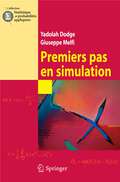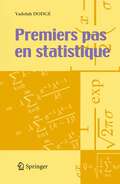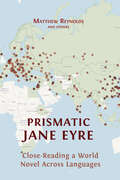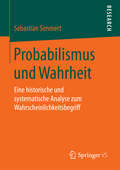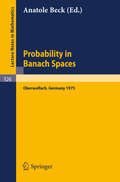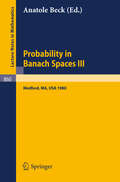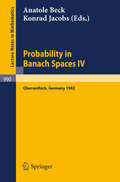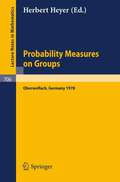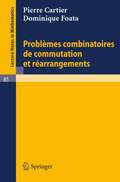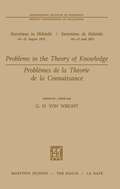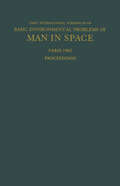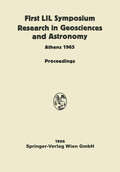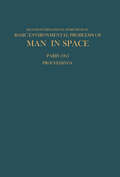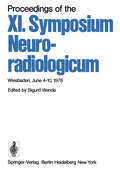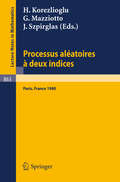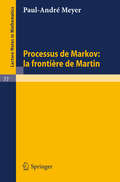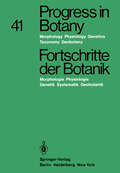- Table View
- List View
Premiers pas en simulation (Statistique et probabilités appliquées)
by Yadolah Dodge Giuseppe Melfi1.1 Pourquoi des techniques de simulation? Les méthodes de simulation, conçues pour être utilisées en statistique et en recherche opérationnelle, ont connu et connaissent encore un développement rapide dû à l’extraordinaire évolution des ordinateurs. Des applications se r- contrenttantdans l’industriequ’enéconomie,ouencoreensciencessociales,en physique des particules, en astronomie et dans de nombreux autres domaines. Dans beaucoup de situations, que ce soit de la vie courante ou dans la - cherchescienti?que,lechercheurestconfrontéàdesproblèmesdontilrecherche des solutions sur la base de certaines hypothèses et contraintes de départ. Pour résoudre ce type de problème, il existe des méthodes analytiques applicables à des situations où le modèle permet de traiter les di?érentes variables par des équations mathématiquement maniables, et des méthodes numériques où la complexité du modèle impose un morcellement du problème, notamment par l’identi?cation des di?érentes variables qui entrent en jeu et l’étude de leurs interactions. Cette dernière approche s’accompagne souvent d’une importante massedecalculs.Lestechniquesdesimulationsontdestechniques numériques: simuler un phénomène signi?e essentiellement reconstituer de façon ?ctive son évolution. Après un bref aperçu historique sur l’évolution du concept de hasard et de sonusageàtraverslessiècles,leParagraphe1.3présentelaproblématiquedela simulationest présentéedans toutesa généralitésous ses di?érents aspects.Les paragraphes suivants montrent des exemples où des techniques de simulation peuvent être appliquées.
Premiers pas en statistique
by Yadolah DodgeCet ouvrage présente les concepts fondamentaux de la théorie statistique et décrit les méthodes les plus souvent utilisées dans la pratique. Il est destiné aux étudiants en sciences économiques et sociales dont le programme d'études inclut une connaissance étendue des méthodes statistiques. Il s'adresse aussi aux chercheurs de divers domaines des sciences appliquées ainsi qu'aux étudiants qui envisagent de poursuivre ultérieurement une étude plus approfondie de la théorie statistique et de ses applications. L'ouvrage comporte trois parties: statistique déscriptive, probabilités et statistique inférentielle.
Prismatic Jane Eyre: Close-Reading a World Novel Across Languages
by Matthew Reynolds OthersJane Eyre, written by Charlotte Brontë and first published in 1847, has been translated more than five hundred times into over sixty languages. Prismatic Jane Eyre argues that we should see these many re-writings, not as simple replications of the novel, but as a release of its multiple interpretative possibilities: in other words, as a prism. Prismatic Jane Eyre develops the theoretical ramifications of this idea, and reads Brontë’s novel in the light of them: together, the English text and the many translations form one vast entity, a multilingual world-work, spanning many times and places, from Cuba in 1850 to 21st-century China; from Calcutta to Bologna, Argentina to Iran. Co-written by many scholars, Prismatic Jane Eyre traces the receptions of the novel across cultures, showing why, when and where it has been translated (and no less significantly, not translated – as in Swahili), and exploring its global publishing history with digital maps and carousels of cover images. Above all, the co-authors read the translations and the English text closely, and together, showing in detail how the novel’s feminist power, its political complexities and its romantic appeal play out differently in different contexts and in the varied styles and idioms of individual translators. Tracking key words such as ‘passion’ and ‘plain’ across many languages via interactive visualisations and comparative analysis, Prismatic Jane Eyre opens a wholly new perspective on Brontë’s novel, and provides a model for the collaborative close-reading of world literature. Prismatic Jane Eyre is a major intervention in translation and reception studies and world and comparative literature. It will also interest scholars of English literature, and readers of the Brontës.
Prismatic Jane Eyre: Close-Reading a World Novel Across Languages
by Matthew Reynolds OthersJane Eyre, written by Charlotte Brontë and first published in 1847, has been translated more than five hundred times into over sixty languages. Prismatic Jane Eyre argues that we should see these many re-writings, not as simple replications of the novel, but as a release of its multiple interpretative possibilities: in other words, as a prism. Prismatic Jane Eyre develops the theoretical ramifications of this idea, and reads Brontë’s novel in the light of them: together, the English text and the many translations form one vast entity, a multilingual world-work, spanning many times and places, from Cuba in 1850 to 21st-century China; from Calcutta to Bologna, Argentina to Iran. Co-written by many scholars, Prismatic Jane Eyre traces the receptions of the novel across cultures, showing why, when and where it has been translated (and no less significantly, not translated – as in Swahili), and exploring its global publishing history with digital maps and carousels of cover images. Above all, the co-authors read the translations and the English text closely, and together, showing in detail how the novel’s feminist power, its political complexities and its romantic appeal play out differently in different contexts and in the varied styles and idioms of individual translators. Tracking key words such as ‘passion’ and ‘plain’ across many languages via interactive visualisations and comparative analysis, Prismatic Jane Eyre opens a wholly new perspective on Brontë’s novel, and provides a model for the collaborative close-reading of world literature. Prismatic Jane Eyre is a major intervention in translation and reception studies and world and comparative literature. It will also interest scholars of English literature, and readers of the Brontës.
Probabilismus und Wahrheit: Eine historische und systematische Analyse zum Wahrscheinlichkeitsbegriff
by Sebastian SimmertDieses Buch zeigt die ideen- und wissenschaftsgeschichtliche Entwicklung des Wahrscheinlichkeitsbegriffs vom Mittelalter bis zum 20. Jhd. auf. Dabei geht Sebastian Simmert vertieft auf die epistemische Bedeutung der Wahrscheinlichkeit als qualitative Bestimmung von Wissen ein. Hierbei untersucht er die Bedingungen der Möglichkeit quantitativer Wahrscheinlichkeit. Im Zentrum steht die Überlegung, dass die elementare Ebene qualitativer Wahrscheinlichkeiten keine Gleichwahrscheinlichkeiten zulässt. Denn sie baut auf einer zweiwertigen Logik auf. Mit dieser Prämisse werden die Grenzen des durch Wahrscheinlichkeiten Aussagbaren aufgezeigt; unter anderem, dass die Anwendung des Gesetzes der großen Zahl keine empirischen Aussagen rechtfertigt.
Probability in Banach Spaces: Proceedings of the First International Conference on Probability in Banach Spaces, 20 - 26 July 1975, Oberwolfach (Lecture Notes in Mathematics #526)
by Anatole BeckProbability in Banach Spaces III: Proceedings of the Third International Conference on Probability in Banach Spaces, Held at Tufts University, Medford, USA, August 4-16, 1980 (Lecture Notes in Mathematics #860)
by A. BeckProbability in Banach Spaces IV: Proceedings of the Seminar Held in Oberwolfach, FRG, July 1982 (Lecture Notes in Mathematics #990)
by A. Beck K. Jacobsa
Probability Measure on Groups VII: Proceedings of a Conference held in Oberwolfach, April 24-30, 1983 (Lecture Notes in Mathematics #1064)
by H. HeyerProbability Measures on Groups: Proceedings of the Fifth Conference Oberwolfach, Germany, January 29th - February 4, 1978 (Lecture Notes in Mathematics #706)
by H. HeyerProbability Measures on Groups: Proceedings of the Sixth Conference Held at Oberwolfach, Germany, June 28-July 4, 1981 (Lecture Notes in Mathematics #928)
by H. Heyera
Probability Measures on Groups IX: Proceedings of a Conference held in Oberwolfach, FRG, January 17-23, 1988 (Lecture Notes in Mathematics #1379)
by Herbert HeyerThe latest in this series of Oberwolfach conferences focussed on the interplay between structural probability theory and various other areas of pure and applied mathematics such as Tauberian theory, infinite-dimensional rotation groups, central limit theorems, harmonizable processes, and spherical data. Thus it was attended by mathematicians whose research interests range from number theory to quantum physics in conjunction with structural properties of probabilistic phenomena. This volume contains 5 survey articles submitted on special invitation and 25 original research papers.
Probability Theory on Vector Spaces IV: Proceedings of a Conference, held in Lancut, Poland, June 10-17, 1987 (Lecture Notes in Mathematics #1391)
by Stamatis Cambanis Aleksander WeronProblemes combinatoires de commutation et rearrangements (Lecture Notes in Mathematics #85)
by Pierre Cartier Dominique FoataProblemi di geometria differenziale in grande: Lectures given at a Summer School of the Centro Internazionale Matematico Estivo (C.I.M.E.) held in Sestriere (Torino), Italy, July 31-August 8, 1958 (C.I.M.E. Summer Schools #16)
by E. BompianiLectures: C.B. Allendörfer: Global differential geometry of imbedded manifolds.- Seminars: P. Libermann: Pseudo-groupes infitésimaux.
Problems in Non-Linear Analysis: Lectures given at a Summer School of the Centro Internazionale Matematico Estivo (C.I.M.E.) held in Varenna (Como), Italy, August 20-29, 1970 (C.I.M.E. Summer Schools #55)
by G. ProdiH. Brezis: Propriétés régularisantes de certains semigroupes et applications.- F. Browder: Normal solvability and existence theorems for nonlinear mappings in Banach spaces.- F. Browder: Normal solvability for nonlinear mappings and the geometry of Banach spaces.- J. Eells, K.D. Elworthy: Wiener integration on certain manifolds.- W.H. Fleming: Nonlinear partial differential equations - Probabilistic and game theoretic methods.- C. Foias: Solutions statistiques des équations d’évolution non linéaires.- J.L. Lions: Quelques problèmes de la théorie des équations non linéaires d’évolution.- A. Pazy: Semi-groups of nonlinear contractions in Hilbert space.- R. Temam: Equations aux dérivées partielles stochastiques.- M.M. Vainberg: Le problème de la minimisation des fonctionnelles non linéaires.
Problems in the Theory of Knowledge / Problèmes de la théorie de la connaissance (Institut International de Philosophie #1)
by G. H. WrightSymposium in Helsinki, 24-27 August 1970 / Entretiens de Helsinki, 24-27 août 1970
Proceedings of the First International Symposium on Basic Environmental Problems of Man in Space: Paris, 29 October — 2 November 1962
by Hilding BjurstedtThis volume contains the communications and discussions of the First Inter national Symposium on Basic Environmental Problems of Man in Space, which was held 29 October - 2 November 1962 at Unesco House, Paris, under the joint sponsorship of the International Astronautical Federation (IAF) and the International Academy of Astronautics (IAA) with the cooperation and support of Unesco, the International Atomic Energy Agency (IAEA) and the World Health Organization (WHO). At this Symposium 31 communications were presented, 8 of which were from the USSR, 8 from the USA, and 15 from other countries, all by special invitation. The presentations, which included three general review papers, were made in ten half-day working sessions by a distinguished international group. The pro ceedings were not restricted to the acute professional aspects of man in space. In fact, the majority of the vast store of material contained in this volume deals with the more scientific aspects, i. e. with problems of the future, which are con tributed mainly by conventional areas of physiology and psychophysiology, including the technical research activities pertaining to the acquisition, analysis and control of biomedical data.
Proceedings of the First Lunar International Laboratory (LIL) Symposium Research in Geosciences and Astronomy: Organized by the International Academy of Astronautics at the XVIth International Astronautical Congress Athens, 16 September, 1965 and Dedicated to the Twentieth Anniversary of UNESCO
by Frank J. MalinaThe Lunar International Laboratory (LIL) project of the International Academy of Astronautics was begun upon the proposal of the editor at the First Special Meeting of the Academy at Stockholm on 16 August 1960. The late THEODORE VON KARMAN, first President of the Academy, appointed the following members of the LIL Committee: Prof. N. BoNEFF (Bulgaria), Prof. M. FLoRKIN (Belgium), Mr. A. G. HALEY (U. S. A. ), Prof. Sir BERNARD LovELL (U. K. ) (Vice Chairman), Prof. L. MALAVARD (France), Dr. F. J. MALINA (U. S. A. ) (Chairman), Prof. H. 0BERTH (German Federal Republic), Dr. W. H. PicKERING (U. S. A. ), Prof. E. SANGER (German Federal Republic), Prof. L. I. SEDOV (U. S. S. R. ), Prof. L. SPITZER, JR. (U. S. A. ), Dr. H. STRUGHOLD (U. S. A. ), Prof. H. C. UREY (U. S. A. ) and himself. Since 1960 the following additional members were appointed to the Committee: Mr. A. C. CLARKE (U. K. ), Prof. A. DoLLFUS (France), Prof. Z. KoPAL (U. K. ), Dr. S. F. SINGER (U. S. A. ), Prof. N. M. SISSAKIAN (U. S. S. R. ) and Prof. F. ZWICKY (Switzerland). The Academy authorized the Committee to study the technical problems related to the construction of a manned research laboratory on the Moon and the feasibility of carrying out its construction, and to consider the fields of research which would initially be undertaken.
Proceedings of the International Congress of Mathematicians: August 3–11, 1994 Zürich, Switzerland
by S. D. ChatterjiSince the first ICM was held in Zürich in 1897, it has become the pinnacle of mathematical gatherings. It aims at giving an overview of the current state of different branches of mathematics and its applications as well as an insight into the treatment of special problems of exceptional importance. The proceedings of the ICMs have provided a rich chronology of mathematical development in all its branches and a unique documentation of contemporary research. They form an indispensable part of every mathematical library. The Proceedings of the International Congress of Mathematicians 1994, held in Zürich from August 3rd to 11th, 1994, are published in two volumes. Volume I contains an account of the organization of the Congress, the list of ordinary members, the reports on the work of the Fields Medalists and the Nevanlinna Prize Winner, the plenary one-hour addresses, and the invited addresses presented at Section Meetings 1 - 6. Volume II contains the invited address for Section Meetings 7 - 19. A complete author index is included in both volumes. '...the content of these impressive two volumes sheds a certain light on the present state of mathematical sciences and anybody doing research in mathematics should look carefully at these Proceedings. For young people beginning research, this is even more important, so these are a must for any serious mathematics library. The graphical presentation is, as always with Birkhäuser, excellent....' (Revue Roumaine de Mathematiques pures et Appliquées)
Proceedings of the Second International Symposium on Basic Environmental Problems of Man in Space: Paris, 14–18 June 1965
by Hilding BjurstedtOrganized by the International Astronautical Federation and the International Academy of Astronautics with the Support and Cooperation of UNESCO, the International Atomic Energy Agency, the WHO, the World Meteorological Organization, andthe International Telecommunication Union
